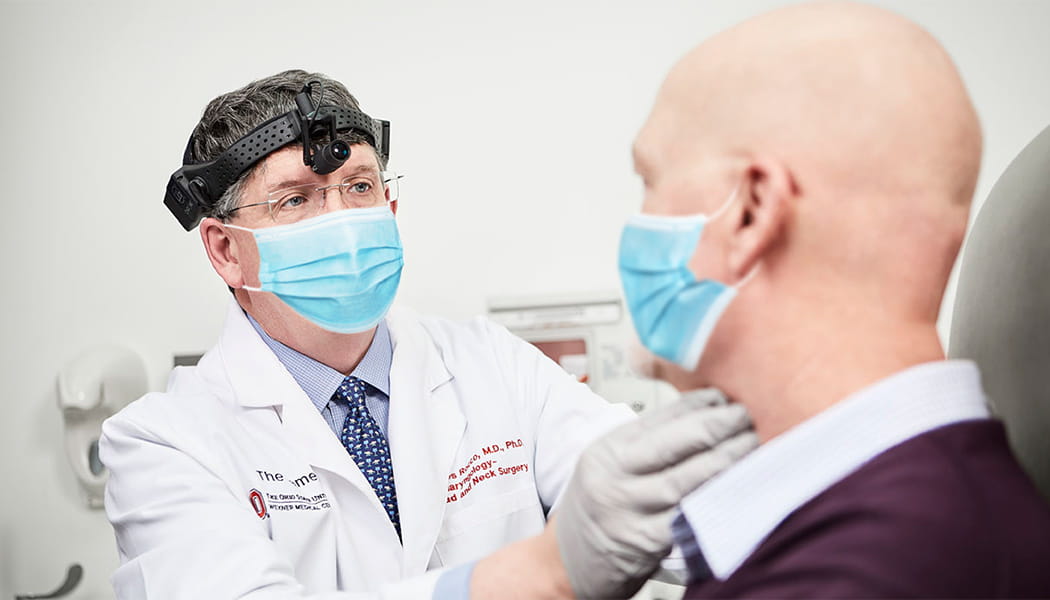
2020 Annual Report

The Head and Neck Surgery team at The Ohio State University Comprehensive Cancer Center – Arthur G. James Cancer Hospital and Richard J. Solove Research Institute (OSUCCC – James) has deployed a novel blood test that detects circulating tumor DNA in 90% of patients with human papillomavirus (HPV)-associated oropharyngeal squamous cell carcinoma (OPSCC).
This innovative test uncovers cancer that can’t be seen during an exam or surgery, or with advanced imaging. The blood test delivers a powerful way to monitor the effectiveness of cancer treatments. It also improves long-term follow-up care for patients by detecting cancer recurrence earlier – before signs appear on imaging and clinical exams.
Now commercially available, the NavDx test from Naveris represents a big jumping off point for innovations in patient care for HPV-related and other types of cancers, says James Rocco, MD, PhD, chair of the Ohio State Department of Otolaryngology – Head and Neck Surgery and director of the Head and Neck Disease-Specific Research Group at the OSUCCC – James.
“This opens a whole new realm of identifying people early in the process and then advancing the sensitivity of the technology,” Dr. Rocco says. “Could this become a screening tool? Can we move from HPV to other cancers?”
Research is underway at Ohio State to explore these avenues.
The NavDx test takes a patient blood sample, spins it down and then examines the plasma for HPV-related DNA from oropharyngeal cancer cells. The test can distinguish between HPV tumor DNA and HPV infection, Dr. Rocco says.
Head and Neck Surgeon Catherine Haring, MD, worked on developing an assay to detect HPV DNA while she was a resident at the University of Michigan. Dr. Haring says her early data and studies show that the blood test accurately finds tumor DNA circulating in the blood stream.
Ohio State took early notice of Dr. Haring’s expertise and her published research about the HPV-circulating tumor DNA assay and its ability to predict treatment response in patients with oropharyngeal cancer.
“We were impressed with her clinical abilities and research potential,” Dr. Rocco says of Dr. Haring, who received her medical degree from George Washington University School of Medicine and completed a residency in Otolaryngology – Head and Neck Surgery at the University of Michigan. She completed her fellowship in head and neck surgical oncology and microvascular reconstruction at The Ohio State University Wexner Medical Center this summer before signing on as an assistant professor within the Ohio State Division of Head and Neck Oncology.
“The James is a world-renowned cancer center that offers the resources, technology and multidisciplinary mentorship to help me move the field of head and neck cancer research forward,” Dr. Haring says. “Joining the Department of Otolaryngology – Head and Neck Surgery at Ohio State was an easy decision.”
Dr. Haring’s research efforts are focused on improving survival and quality of life in patients with head and neck cancer by utilizing novel diagnostic approaches.
When the HPV virus causes cancer, it invades healthy cells and leaves its DNA in the cytoplasm of these cells. Some cells may carry thousands of copies of the HPV DNA while others may have just a few. Dr. Rocco compares it to the difference between a dim LED light bulb and a bright halogen light.
As infected cells replicate, they have the potential to convert into cancerous cells and tumors. As a tumor grows, cells release fragments of DNA into the blood stream.
“Our data has shown that the amount of HPV tumor DNA in the bloodstream directly correlates to the size of the tumor,” Dr. Haring says. “High levels of HPV DNA often indicate that a larger tumor is present.”
The NavDx test offers a minimally invasive approach to assess tumor burden before, during and after treatment. And changes in DNA levels over time may provide information as to how a patient is responding to treatment.
This blood-based biomarker can replace the need for invasive tissue biopsies of the throat that require surgery, Dr. Haring says.
The NavDx test was recently used to help a patient whose cancer returned after treatment. The patient was diagnosed with a basic tongue cancer and received radiation and chemotherapy. A positron emission tomography (PET)/computed tomography (CT) scan showed he was free of disease.
Dr. Rocco administered the NavDx test on the patient, which indicated high levels of HPV DNA in the blood. Despite a thorough office exam, and examination under anesthesia, the team was unable to detect residual tumor. Based on these findings, and after tumor board discussion, the head and neck team received insurance approval to perform a repeat PET CT scan on the patient. The scan revealed likely metastasis to the liver as the source of circulating tumor DNA. The patient will undergo a liver biopsy and a treatment plan will be developed from there.
“This is new and exciting ground for us,” Dr. Rocco says. “In the future, how rapidly cancer DNA levels drop during therapy may be predictive of who is likely to be cured or not. It may also identify which treatments should be used in a specific patient. Finally, this could evolve into something we use to screen people at risk prior to cancer development.”
HPV-associated oropharyngeal squamous cell carcinoma occurs most often in white men between ages 45 and 65. The rate of diagnosis for this type of throat cancer in nonsmokers is on the rise, Dr. Haring says.
“These patients tend to have an improved prognosis compared to patients with smoking-related throat cancer,” Dr. Haring says. “We want to be able to personalize treatment for these patients, avoiding unnecessary treatment and potential side effects.”
In ideal situations, the new blood test will be used at the time of diagnosis, during treatment and after treatment, to monitor changes in the levels of HPV DNA. If treatments are working, the level of HPV DNA in the blood should drop as the cancer is destroyed.
If those levels rise or remain steady, that data can be used to adjust treatments to look for a recurrence. This also opens the door to using the test as a screening tool, especially because it’s a minimally invasive blood test.
“It offers early detection in asymptomatic patients, so we can predict who might develop cancer in the future,” Dr. Haring says. “It has the potential to serve as a predictive biomarker.”
The Head and Neck Surgery team was immediately intrigued by NavDx’s potential.
“For a small percentage of patients, we might know the cancer is there, but we don’t know where it is,” Dr. Rocco says. “The test tells us it is still there, but we can’t localize it.”
The most sensitive imaging available to detect cancer is the PET CT scan. If that advanced imaging shows no evidence of disease but the NavDx test detects cancer DNA, what’s the best course of action?
“We’re trying to figure it out now,” Dr. Rocco says. “This is unfolding in real time.”
Doctors must decide if they should employ watchful waiting, schedule regular screenings or start systemic treatment.
Studies are underway to improve the test’s performance status. Dr. Haring says the goal is to get the test to detect HPV cancer DNA in 100% of patients. When that happens, science will be closer to potentially using this blood test as a screening test for HPV cancer, in the same way a colonoscopy or mammogram is employed.